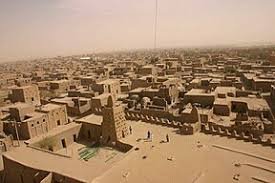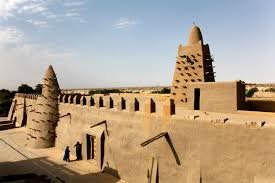Timbuktu is an ancient city in Mali, situated 20 kilometres (12 miles) north of the Niger River. It is the capital of the Tombouctou Region, one of the eight administrative regions of Mali, having a population of 32,460 in the 2018 census.
Timbuktu was founded about 1100 CE as a seasonal camp by Tuareg nomads. There are several stories concerning the derivation of the city’s name. According to one tradition, Timbuktu was named for an old woman left to oversee the camp while the Tuareg roamed the Sahara. Her name (variously given as Tomboutou, Timbuktu, or Buctoo) meant “mother with a large navel,” possibly describing an umbilical hernia or other such physical malady. Timbuktu’s location at the meeting point of desert and water made it an ideal trading centre. In the late 13th or early 14th century it was incorporated into the Mali empire.

By the 14th century Timbuktu was a flourishing centre for the trans-Saharan gold and salt trade, and it grew as a centre of Islamic culture. Three of western Africa’s oldest mosques—Djinguereber (Djingareyber), Sankore, and Sidi Yahia—were built there during the 14th and early 15th centuries. After an extravagant pilgrimage to Mecca in 1324, the Mali emperor Mansa Mūsā built the Great Mosque (Djinguereber) and a royal residence, the Madugu (the former has since been rebuilt many times, and of the latter no trace remains). The Granada architect Abū Isḥāq al-Sāḥili was then commissioned to design the Sankore mosque, around which Sankore University was established. The mosque still stands today, probably because of al-Sāḥili’s directive to incorporate a wooden framework into the mud walls of the building, thus facilitating annual repairs after the rainy season.
The Tuareg regained control of the city in 1433, but they ruled from the desert. Although the Tuareg exacted sizable tributes and plundered periodically, trade and learning continued to flourish in Timbuktu. By 1450 its population increased to about 100,000. The city’s scholars, many of whom had studied in Mecca or in Egypt, numbered some 25,000.
Archaeological evidence suggests prehistoric settlements in the region, predating the city’s Islamic scholarly and trade prominence in the medieval period. Timbuktu began as a seasonal settlement and became permanent early in the 12th century. After a shift in trading routes, particularly after the visit by Mansa Musa around 1325, Timbuktu flourished, due to its strategic location, from the trade in salt, gold, and ivory. It gradually expanded as an important Islamic city on the Saharan trade route and attracted many scholars and traders before it became part of the Mali Empire early in the 14th century. In the first half of the 15th century, the Tuareg people took control for a short period, until the expanding Songhai Empire absorbed it in 1468.
In 1468 the city was conquered by the Songhai ruler Sonni ʿAlī. He was generally ill disposed toward the city’s Muslim scholars, but his successor—the first ruler of the new Askia dynasty, Muḥammad I Askia of Songhai (reigned 1493–1528)—used the scholarly elite as legal and moral counselors. During the Askia period (1493–1591) Timbuktu was at the height of its commercial and intellectual development. Merchants from Ghudāmis (Ghadamis; now in Libya), Augila (now Awjidah, Libya), and numerous other cities of North Africa gathered there to buy gold and slaves in exchange for the Saharan salt of Taghaza and for North African cloth and horses.
After it was captured by Morocco in 1591, the city declined. Its scholars were ordered arrested in 1593 on suspicion of disaffection; some were killed during a resulting struggle, while others were exiled to Morocco. Perhaps worse still, the small Moroccan garrisons placed in command of the city offered inadequate protection, and Timbuktu was repeatedly attacked and conquered by the Bambara, Fulani, and Tuareg.

A Moroccan army defeated the Songhai in 1591 and made Timbuktu their capital. The invaders established a new ruling class, the Arma, who after 1612 became virtually independent of Morocco. In its golden age, the town’s Islamic scholars and extensive trade network supported an important book trade. Together with the campuses of the Sankoré Madrasah, an Islamic university, this established Timbuktu as a scholarly centre in Africa. Notable historic writers, such as Shabeni and Leo Africanus, wrote about the city. These stories fuelled speculation in Europe, where the city’s reputation shifted from being rich to mysterious. The city’s golden age as a major learning and cultural centre of the Mali Empire was followed by a long period of decline. Different tribes governed until the French took over Mali in 1893, in a regime that lasted until the country became the Republic of Mali in 1960.
In recent history, Timbuktu faced threats from extremist groups leading to the destruction of cultural sites; efforts by local and international communities have aimed to preserve its heritage. The city’s population has declined as a result of the recent issues.
Meaning and Variations of the description ‘Timbuktu’
Over the centuries, the spelling of Timbuktu has varied a great deal: from Tenbuch on the Catalan Atlas (1375), to traveller Antonio Malfante’s Thambet, used in a letter he wrote in 1447 and also adopted by Alvise Cadamosto in his Voyages of Cadamosto, to Heinrich Barth’s Timbúktu and Timbu’ktu. French spelling often appears in international reference as ‘Tombouctou’. The German spelling ‘Timbuktu’ and its variant ‘Timbucktu’ have passed into English and the former has become widely used in recent years. Major English-language works have employed the spelling ‘Timbuctoo’, and this is considered the correct English form by scholars; ‘Timbuctou’ and ‘Timbuctu’ are sometimes used as well.
The French continue to use the spelling ‘Tombouctou’, as they have for over a century; variants include ‘Temboctou’ (used by explorer René Caillié) and ‘Tombouktou’, but they are seldom seen. Variant spellings exist for other places as well, such as Jenne (Djenné) and Segu (Ségou). As well as its spelling, Timbuktu’s toponymy is still open to discussion. At least four possible origins of the name of Timbuktu have been described:
Stay tuned to our website www.globalafricantimes.com for the continuation in this African History Series centered on Timbuktu in Mali.





